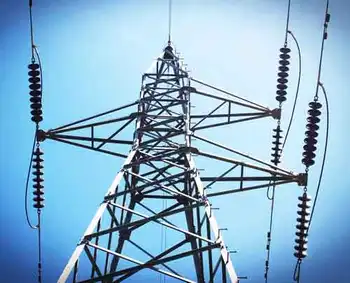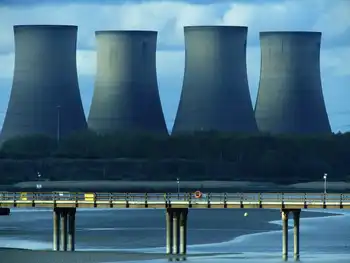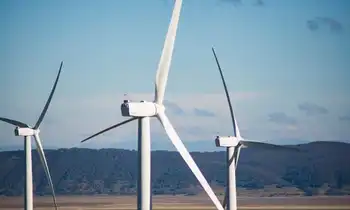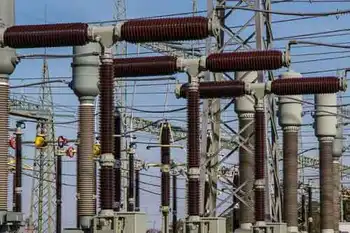Wind-power industry seeks trained workforce
By Los Angeles Times
NFPA 70e Training
Our customized live online or in‑person group training can be delivered to your staff at your location.

- Live Online
- 6 hours Instructor-led
- Group Training Available
But that was before construction jobs vanished like a fast-moving dust storm in this blustery high desert. Hard times have brought them to a classroom in rural Kern County to learn a different trade. Tonight's lesson: how to avoid death and dismemberment.
This is Wind Technology Boot Camp at Cerro Coso Community College, where eight weeks of study and $1,000 in tuition might lead to a job repairing mammoth wind turbines like the ones sprouting up across this region.
The work requires smarts and stamina. It is potentially dangerous. Candidates need good knees, a cool head — and a stomach for heights.
"I've seen guys just freeze halfway up the tower," said instructor Merritt Mays, a baby-faced former Marine, who at 29 is already a grizzled veteran in this young industry.
For those who can hack it, starting pay ranges from $15 to $20 an hour. Crack technicians can make six figures a year. Wind farms are hiring and probably will be for years to come. That's luring hard hats like 49-year-old Chuck Patterson back to school, despite the inherent risks of working 300 feet in the air.
"This is where the money's going to be," said the Ridgecrest, Calif., contractor, who likes the idea of a steady paycheck after years of construction boom and bust.
As in previous recessions, this economic downturn is boosting enrollment at community colleges and vocational schools. Classrooms are swelling with workers from hard-hit industries who are looking to change careers.
Educators say the difference this time is the surging interest in so-called green-collar jobs. President Obama wants to create 5 million of them over the next decade. What isn't clear is how the U.S. is going to prepare this workforce.
Technical education for renewable-energy workers is scarce, particularly for the fast-growing wind industry. Only a handful of wind programs operate in community colleges. Cerro Coso filled the 15 slots in its boot camp within hours. The next course is already full.
The U.S. last year surpassed Germany as the world's No. 1 wind-powered nation, with more than 25,000 megawatts in place. Wind could supply 20% of America's electricity needs by 2030, up from less than 1% now, according to a recent Energy Department report.
California is the No. 3 wind state, behind Texas and Iowa. A slew of developments are in the pipeline, including in Kern County, where hundreds of turbines already dot the wind-swept ridges of the Tehachapi mountain range.
"This is going to be ground zero for alternative energy" in California, said Jim Fay, vice president of academic affairs at Cerro Coso Community College, which has five campuses in Kern County. "We have to prepare our students."
The economic crisis has dampened growth in the renewable sector. But the U.S. wind industry is clamoring for skilled technicians to maintain the 30,000 wind turbines already in the ground. The best workers combine the knowledge of a top-flight mechanic with the endurance of an alpine mountaineer.
"It's like [working on] a school bus on top of a really long pole," said Bob Ward, a marketing manager for sensing and inspection technologies for General Electric Co., one of the world's top turbine makers. "It's complex. This isn't some Jiffy Lube job."
A typical 1.5-megawatt GE unit costs $2.5 million installed. It sits about 30 stories above the ground at the hub, where its three 100-foot-long blades connect to the tower.
Just behind the hub is the housing for the gearbox, drive train and other components. Think of this as the wind technician's office. Except there's no elevator. Reaching it means climbing rung by rung on a narrow steel ladder attached to the inside of the tower. An agile worker can do it in less than 10 minutes, several times a day.
"You earn every dollar you make in this industry. It's plain hard work," said Dan Templeton, program chairman for wind energy at Texas State Technical College West Texas.
Advice to hopefuls: Quit smoking. Lose that gut. And don't try this with a hangover.
Technicians must be hyper-vigilant in an occupation that combines dizzying heights, tight spaces, high-voltage electricity and spinning metal.
Fatalities are rare but unspeakably gruesome.
Workers have plunged to their deaths, been electrocuted and been ground to a pulp by rotating machinery.
Teaching students to respect these beasts is the job of wind instructors such as Mays, who grew up on a ranch in nearby Tehachapi.
His employer, Airstreams, is a private wind-training firm working with Cerro Coso to put on the eight-week boot camp. On a recent evening, Mays lectured students on the importance of daily inspection of the safety harness, the lifeline that every wind technician straps on before climbing.
"This is what's going to save your life, so you'd better be sure it's working," Mays said. "I don't want to be the one to have to look your wife in the eye and tell her that you're gone."
The potential danger doesn't appear to faze 18-year-old Shelby Young of California City, a dirt-bike rider and the only woman in the class.
"I like the adrenaline rush," she said.
Josh Gates' biggest worry is supporting his family. The unemployed builder, 27, left his pregnant wife and young son in Greenville, Utah, to attend the class. He bunks in a friend's motor home, making the long drive home every few weeks.
"It's going to pay off in the end," he said.
The near certainty of landing a job that pays well has students scampering for available training spots.
Mesalands Community College in Tucumcari, N.M., launched its wind program last fall with 32 students. GE offered to hire every qualified graduate for three years, leading to a nationally televised news story. The school has since been flooded with hundreds of inquiries from across the country, spokesman John Yearout said. He's scrambling to find another instructor.
It's much the same at Iowa Lakes Community College, where wind students have "two to three job offers each" by the time they complete the two-year program, spokeswoman Angie DeJong said.
The school will admit 102 students this fall, up from the 72 it had planned to take, because of surging demand, she said. Inquiries come in daily from the jobless. On a recent morning it was an unemployed Nebraska engineer, then a Michigan autoworker.
"We're seeing a lot of nontraditional students with families who have gotten laid off," she said.
California's community colleges are trying to get wind technicians into the workforce faster with the accelerated boot camp system. Cerro Coso and Shasta College in Redding are the first institutions out of the gate. More are on the way.
The goal is to have 50 schools around the state offering wind training within a few years, said Peter Davis, director of the community college system's Advanced Transportation Technologies and Energy initiative.
That could prove a tall order considering California's budget woes.
Students are jumping at the few seats available now. Laid-off house framer Shane Culleton of Rosamond, Calif., borrowed $1,000 from his mother-in-law to enroll in the Cerro Coso boot camp. The 29-year-old father of three is so confident that he'll find a job that he vowed to sell his beloved motorcycle if he fails.
"It's going to be a while before construction comes back," he said. "I've got to do something."











